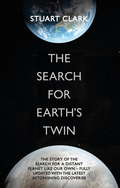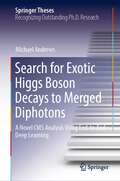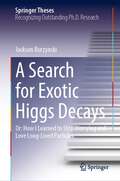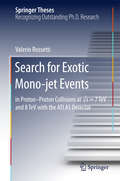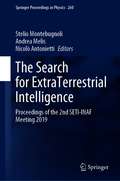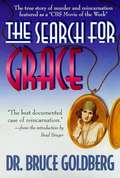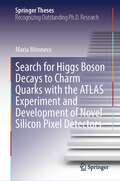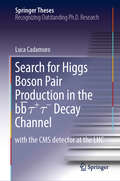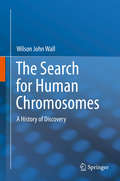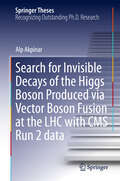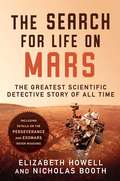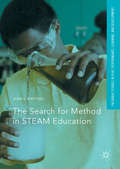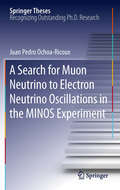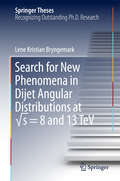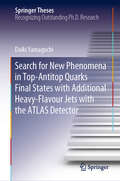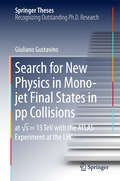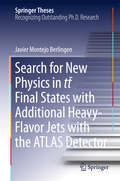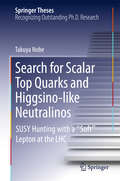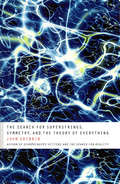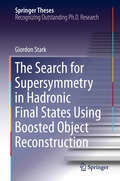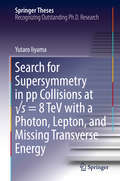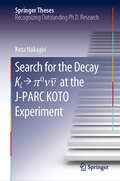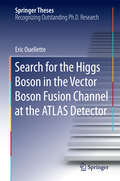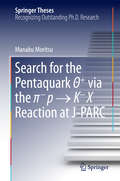- Table View
- List View
The Search For Earth's Twin
by Stuart ClarkThe true, cutting-edge story of man's epic quest to find an Earth-like planet capable of sustaining complex life.In 1995 two Swiss astronomers discovered a planet circling a star other than our Sun. This changed our perception of the Universe forever, proving that Earth and the other celestial bodies in our Solar System are not alone in outer space. Now, after two decades of exploration, more than 860 planets have been discovered, many of which are completely unlike anything else we know. Some are blacker than coal; some are bathed in molten lava; others are perpetually scoured by hurricane-force winds; some have not one sun but two that rise in the morning, and others are perpetually drowned in global oceans. But as well as strange, uninhabitable lands, there is familiarity too. Some of these alien worlds are strikingly similar to planets in our Solar System. Astronomers now know of planets just like Jupiter, Neptune, Mars and Mercury orbiting stars similar to our Sun, both nearby and deep into space. Authoritatively written and fully up to date on this fast-moving area of science, The Search for the Earth's Twin will take you on a journey through the cosmos via frozen wastelands, slow-moving globes and fiery volcanic bodies, to planets that can - and just might - sustain complex life. The prospect of discovering the Earth's twin is now tantalisingly close.
Search for Exotic Higgs Boson Decays to Merged Diphotons: A Novel CMS Analysis Using End-to-End Deep Learning (Springer Theses)
by Michael AndrewsThis book describes the first application at CMS of deep learning algorithms trained directly on low-level, “raw” detector data, or so-called end-to-end physics reconstruction. Growing interest in searches for exotic new physics in the CMS collaboration at the Large Hadron Collider at CERN has highlighted the need for a new generation of particle reconstruction algorithms. For many exotic physics searches, sensitivity is constrained not by the ability to extract information from particle-level data but by inefficiencies in the reconstruction of the particle-level quantities themselves. The technique achieves a breakthrough in the reconstruction of highly merged photon pairs that are completely unresolved in the CMS detector. This newfound ability is used to perform the first direct search for exotic Higgs boson decays to a pair of hypothetical light scalar particles H→aa, each subsequently decaying to a pair of highly merged photons a→yy, an analysis once thought impossible to perform. The book concludes with an outlook on potential new exotic searches made accessible by this new reconstruction paradigm.
A Search for Exotic Higgs Decays: Or: How I Learned to Stop Worrying and Love Long-Lived Particles (Springer Theses)
by Jackson BurzynskiThe absence of new physics at the TeV scale observed thus far at the Large Hadron Collider (LHC) motivates an increasing focus on searches for weakly-coupled new particles and exotic signatures. In particular, particles with macroscopic mean proper lifetimes, known as long-lived particles (LLPs), are of significant interest due to their ability to elude the majority of searches which rely on the assumption that Beyond Standard Model particles decay close to the primary interaction point. Many models which aim to solve various issues with the Standard Model (SM) introduce new particles with lifetimes that are either unconstrained, or even shown to prefer the macroscopic regime. These theories often point to the Higgs boson as a possible portal to new physics, with exotic Higgs decays being the primary phenomenological consequence and means of discovery. It is well motivated both from theory and experimental constraints to consider the scenario in which the particles produced in these exotic decays have macroscopic proper lifetimes and give rise to unique detector signatures.This work describes a search for exotic decays of the Higgs boson to two long-lived, neutral, spin-0 particles which subsequently decay to pairs of b quarks, giving the striking signature of displaced hadronic jets in the ATLAS inner detector. Several other ATLAS searches have probed this decay topology previously, excluding branching ratios of the Higgs boson to LLPs of more than 10% for proper lifetimes greater than 100mm. These searches relied on dedicated triggers designed to select events with LLPs decaying in the ATLAS calorimeter or muon spectrometer. The lack of an equivalent trigger for LLP decays in the ATLAS inner detector has been a limiting factor in probing LLP lifetimes less than 100mm. To circumvent the difficulty of triggering on LLP decays, the search presented in this thesis exploits the ZH associated production mode, relying on leptonic trigger signatures to select interesting events. This is the first search for Higgs boson decays into LLPs to exploit this analysis methodology and additionally makes use of several novel methods for both background rejection and background estimation.No excess over Standard Model predictions is observed, and upper limits are set on the branching ratio of the Higgs boson to LLPs . Depending on the mass of the LLP, branching ratios greater than 10% are excluded for lifetimes as small as 4mm and as large as 100mm, probing an important gap in the ATLAS exotic Higgs decay programme. In comparison to the previous searches for Higgs decays to LLPs, these are among the most stringent limits placed on this scenario, and for LLPs with masses below 40 GeV these results represent the strongest existing constraints on the branching ratio of the Higgs boson to LLPs in this lifetime regime.
Search for Exotic Mono-jet Events
by Valerio RossettiThis thesis describes in detail the search for new phenomena in mono-jet final states with the ATLAS experiment at the LHC. The final state is considered the golden channel in the searches for large extra dimensions (LED) but also allows access to a very rich SUSY-related phenomenology pertaining to the production of weakly interacting massive particles (WIMPS), SUSY Dark Matter candidates, GMSB SUSY models with very light gravitino masses, as well as stop an sbottom pair production in compressed scenarios (with nearly degenerated squarks and the lightest neutralino), and also invisible Higgs searches, among others. Here, a number of these scenarios are explored. The measurements presented yield new powerful constraints on the existence of extra spatial dimensions, the pair production of WIMPs, and also provide the best limit to date on the gravitino mass.
The Search for ExtraTerrestrial Intelligence: Proceedings of the 2nd SETI-INAF Meeting 2019 (Springer Proceedings in Physics #260)
by Stelio Montebugnoli Andrea Melis Nicolò AntoniettiThis book presents the latest knowledge of the newly discovered Earth-like exoplanets and reviews improvements in both radio and optical SETI. A key aim is to stimulate fresh discussion on algorithms that will be of high value in this extremely complicated search. Exoplanets resembling Earth could well be able to sustain life and support the evolution of technological civilizations, but to date, all searches for such life forms have proved fruitless. The failings of SETI observations are well recognized, and a new search approach is necessary. In this book, different detection algorithms that exploit state-of-the-art, low-cost, and extremely fast multiprocessors are examined and compared. Novel methods such as the agnostic entropy and high-sensitivity blind signal extraction algorithms should represent a quantum leap forward in SETI. The book is of interest to all researchers in the field and hopefully stimulates significant progress in the search for extraterrestrial intelligence.
The Search for Grace: The True Story of Murder and Reincarnation
by Bruce GoldbergAn unsolved murder mystery on the books since 1927 one modern woman's obsession with an abusive lover and a karmic journey that winds through a maze of past lives- all of these unite into the best-documented case of reincarnation in the Western world. "... There is no way that the CBS movie could reflect the powerful obsession that brought Ivy back to my office to be regressed again and again, forty-five times. Long after both of us felt that our initial therapeutic goals had been achieved, something in Ivy would not let her rest until she had relived the forty-sixth life and brought to light the circumstances of what the Buffalo, N.Y., police still listed as an unsolved homicide over sixty years later." -Dr. Bruce Goldberg
Search for Higgs Boson Decays to Charm Quarks with the ATLAS Experiment and Development of Novel Silicon Pixel Detectors (Springer Theses)
by Maria MironovaThis book explores the Higgs boson and its interactions with fermions, as well as the detector technologies used to measure it. The Standard Model of Particle Physics has been a groundbreaking theory in our understanding of the fundamental properties of the universe, but it is incomplete, and there are significant hints which require new physics. The discovery of the Higgs boson in 2012 was a substantial confirmation of the Standard Model, but many of its decay modes remain elusive. This book presents the latest search for Higgs boson decays into c-quarks using a proton-proton collision dataset collected by the ATLAS experiment at the Large Hadron Collider (LHC). This decay mode has yet to be observed and requires advanced machine learning algorithms to identify c-quarks in the experiment. The results provide an upper limit on the rate of Higgs boson decays to c-quarks and a direct measurement of the Higgs boson coupling strength to c-quarks. The book also discusses the future of particle physics and the need for significant improvements to the detector to cope with increased radiation damage and higher data rates at the High-Luminosity LHC. It presents the characterization of the ATLAS pixel detector readout chip for the inner detector upgrade (ITk). The chip was subjected to irradiations using X-rays and protons to simulate the radiation environment at the HL-LHC. The tests showed that all readout chip components, including the digital logic and analogue front-end, are sufficiently radiation-tolerant to withstand the expected radiation dose. Finally, this book describes monolithic pixel detectors as a possible technology for future pixel detectors. This book is ideal for individuals interested in exploring particle physics, the Higgs boson, and the development of silicon pixel detectors.
Search for Higgs Boson Pair Production in the bb̅ τ+ τ- Decay Channel: with the CMS detector at the LHC (Springer Theses)
by Luca CadamuroThis thesis presents innovative contributions to the CMS experiment in the new trigger system for the restart of the LHC collisions in Run II, as well as original analysis methods and important results that led to official publications of the Collaboration.The author's novel reconstruction algorithms, deployed on the Field-Programmable Gate Arrays of the new CMS trigger architecture, have brought a gain of over a factor 2 in efficiency for the identification of tau leptons, with a very significant impact on important H boson measurements, such as its decays to tau lepton pairs and the search for H boson pair production.He also describes a novel analysis of HH → bb tautau, a high priority physics topic in a difficult channel. The original strategy, optimisation of event categories, and the control of the background have made the result one of the most sensitive concerning the self-coupling of the Higgs boson among all possible channels at the LHC.
The Search for Human Chromosomes
by Wilson John WallThis book is a broadly historical account of a remarkable and very exciting scientific story-the search for the number of human chromosomes. It covers the processes and people, culminating in the realization that discovering the number of human chromosomes brought as much benefit as unraveling the genetic code itself. With the exception of red blood cells, which have no nucleus and therefore no DNA, and sex cells, humans have 46 chromosomes in every single cell. Not only do chromosomes carry all of the genes that code our inheritance, they also carry them in a specific order. It is essential that the number and structure of chromosomes remains intact, in order to pass on the correct amount of DNA to succeeding generations and for the cells to survive. Knowing the number of human chromosomes has provided a vital diagnostic tool in the prenatal diagnosis of genetic disorders, and the search for this number and developing an understanding of what it means are the focus of this book.
Search for Invisible Decays of the Higgs Boson Produced via Vector Boson Fusion at the LHC with CMS Run 2 data (Springer Theses)
by Alp AkpinarThis thesis reports the latest measurements on one of the leading dark matter searches conducted by the Compact Muon Solenoid (CMS) experiment at CERN, leading to some of the most stringent constraints on hypothesized interactions between the Higgs boson and dark matter. The thesis also includes further research about the future outlook of the experiment, including exploratory research on the adaptation of deep learning models in future dark matter analyses to improve analysis sensitivity, and the design of a new type of data processing hardware to be used in the next phase of the CMS experiment.
The Search for Life on Mars: The Greatest Scientific Detective Story of All Time
by Elizabeth Howell Nicholas BoothPublished to coincide with the launch of NASA&’s Perseverance rover mission this summer, the definitive account of our quest to find life on the Red Planet. From The War of the Worlds to The Martian and to the amazing photographs sent back by the robotic rovers Curiosity and Opportunity, Mars has excited our imaginations as the most likely other habitat for life in the solar system. Now the Red Planet is coming under scrutiny as never before. As new missions are scheduled to launch this year from the United States and China, and with the European Space Agency's ExoMars mission now scheduled for 2022, this book recounts in full the greatest scientific detective story ever. For the first time in forty years, the missions heading to Mars will look for signs of ancient life on the world next door. It is the latest chapter in an age‑old quest that encompasses myth, false starts, red herrings, and bizarre coincidences—as well as triumphs and heartbreaking failures. This book, by two journalists with deep experience covering space exploration, is the definitive story of how life's discovery has eluded us to date, and how it will be found somewhere and sometime this century. The Search for Life on Mars is based on more than a hundred interviews with experts at NASA&’s Jet Propulsion Laboratory and elsewhere, who share their insights and stories. While it looks back to the early Mars missions such as Viking 1 and 2, the book's focus is on the experiments and revelations from the most recent ones—including Curiosity, which continues to explore potentially habitable sites where water was once present, and the Mars Insight lander, which has recorded more than 450 marsquakes since its deployment in late 2018—as well as on the Perseverance and ExoMars rover missions ahead. And the book looks forward to the newest, most exciting frontier of all: the day, not too far away, when humans will land, make the Red Planet their home, and look for life directly.
The Search for Method in STEAM Education
by Jaime E. MartinezThis book explores various approaches to building a positive interdisciplinary STEAM (science, technology, engineering, arts and math) learning environment, as described by educators across the K-20 educational ladder. Crucial to their success, Martinez finds, is the playful and performatory approach they employ in their teaching. Their practices are creative, improvisational, and inclusive, and are shared in detail through illustrations and interviews. Throughout the book, the author explores a Vygotskian cultural performatory approach to creating interdisciplinary STEAM learning environments, drawing out the history of this approach and its success in fostering collaboration, creativity, leadership, and communication skills, as well as its effect on social, emotional, and cognitive growth in both formal and informal educational settings.
A Search for Muon Neutrino to Electron Neutrino Oscillations in the MINOS Experiment (Springer Theses)
by Juan Pedro Ochoa-RicouxThe centerpiece of the thesis is the search for muon neutrino to electron neutrino oscillations which would indicate a non-zero mixing angle between the first and third neutrino generations (θ13), currently the "holy grail" of neutrino physics. The optimal extraction of the electron neutrino oscillation signal is based on the novel "library event matching" (LEM) method which Ochoa developed and implemented together with colleagues at Caltech and at Cambridge, which improves MINOS' (Main Injector Neutrino Oscillator Search) reach for establishing an oscillation signal over any other method. LEM will now be the basis for MINOS' final results, and will likely keep MINOS at the forefront of this field until it completes its data taking in 2011. Ochoa and his colleagues also developed the successful plan to run MINOS with a beam tuned for antineutrinos, to make a sensitive test of CPT symmetry by comparing the inter-generational mass splitting for neutrinos and antineutrinos. Ochoa's in-depth, creative approach to the solution of a variety of complex experimental problems is an outstanding example for graduate students and longtime practitioners of experimental physics alike. Some of the most exciting results in this field to emerge in the near future may find their foundations in this thesis.
Search for New Phenomena in Dijet Angular Distributions at √s = 8 and 13 TeV (Springer Theses)
by Lene Kristian BryngemarkThis thesis describes the use of the angular distributions of the most energetic dijets in data recorded by the ATLAS experiment, at CERN's Large Hadron Collider (LHC), the goal of which is to search for phenomena beyond what the current theory of Particle Physics (the Standard Model) can describe. It also describes the deployment of the method used in ATLAS to correct for the distortions in jet energy measurements caused by additional proton-proton interactions. The thesis provides a detailed introduction to understanding jets and dijet searches at the LHC. The experiments were carried out at two record collider centre-of-mass energies (8 and 13 TeV), probing smaller distances than ever before. Across a broad momentum transfer range, the proton constituents (quarks and gluons) display the same kinematical behaviour, and thus still appear to be point-like. Data are compared to predictions corrected for next-to-leading order quantum chromodynamics (NLO QCD) as well as electroweak effects, demonstrating excellent agreement. The results are subsequently used to set limits on parameters of suggested theoretical extensions to the Standard Model (SM), including the effective coupling and mass of a Dark Matter mediator.
Search for New Phenomena in Top-Antitop Quarks Final States with Additional Heavy-Flavour Jets with the ATLAS Detector (Springer Theses)
by Daiki YamaguchiThis book reports on the search for a new heavy particle, the Vector-Like Top quark (VLT), in the Large Hadron Collider (LHC) at CERN. The signal process is the pair production of VLT decaying into a Higgs boson and top quark (TT→Ht+X, X=Ht, Wb, Zt). The signal events result in top–antitop quarks final states with additional heavy flavour jets. The book summarises the analysis of the data collected with the ATLAS detector in 2015 and 2016. In order to better differentiate between signals and backgrounds, exclusive taggers of top quark and Higgs boson were developed and optimised for VLT signals. These efforts improved the sensitivity by roughly 30%, compared to the previous analysis. The analysis outcomes yield the strongest constraints on parameter space in various BSM theoretical models. In addition, the book addresses detector operation and the evaluation of tracking performance. These efforts are essential to properly collecting dense events and improving the accuracy of the reconstructed objects that are used for particle identification. As such, they represent a valuable contribution to data analysis in extremely dense environments.
Search for New Physics in Mono-jet Final States in pp Collisions
by Giuliano GustavinoThis thesis provides a detailed and comprehensive description of the search for New Physics at the Large Hadron Collider (LHC) in the mono-jet final state, using the first 3. 2 fb$^{{-1}}$ of data collected at the centre of mass energy of colliding protons of 13 TeV recorded in the ATLAS experiment at LHC. The results are interpreted as limits in different theoretical contexts such as compressed supersymmetric models, theories that foresee extra-spatial dimensions and in the dark matter scenario. In the latter the limits are then compared with those obtained by other ATLAS analyses and by experiments based on completely different experimental techniques, highlighting the role of the mono-jet results in the context of dark matter searches. Lastly, a set of possible analysis improvements are proposed to reduce the main uncertainties that affect the signal region and to increase the discovery potential by further exploiting the information on the final state.
Search for New Physics in tt Final States with Additional Heavy-Flavor Jets with the ATLAS Detector
by Javier Montejo BerlingenThis doctoral thesis focuses on the search for new phenomena in top-antitop quark (tt) final states with additional b-quark jets at the LHC. It uses the full Run 1 dataset collected by the ATLAS experiment in proton-proton collisions at √s=8 TeV. The final state of interest consists of an isolated lepton, a neutrino and at least six jets with at least four b-tagged jets, a challenging experimental signature owing to the large background from tt+heavy-flavor production. This final state is characteristic of ttH production, with the Higgs boson decaying into bb, a process that allows direct probing of the top-Higgs Yukawa coupling. This signature is also present in many extensions of the Standard Model that have been proposed as solutions to the hierarchy problem, such as supersymmetry or composite Higgs models, which predict the pair production of bosonic or fermionic top quark partners, or the anomalous production of four-top-quark events. All these physics processes have been searched for using an ambitious search strategy that has been developed on the basis of a combination of state-of-art theoretical predictions and a sophisticated statistical analysis to constrain in-situ the large background uncertainties. As a result, the most restrictive bounds to date on the above physics processes have been obtained.
Search for Scalar Top Quarks and Higgsino-Like Neutralinos
by Takuya NobeThis book reports a search for theoretically natural supersymmetry (SUSY) at the Large Hadron Collider (LHC). The data collected with the ATLAS detector in 2012 corresponding to 20 /fb of an integrated luminosity have been analyzed for stop pair production in proton-proton collisions at a center-of-mass energy of 8 TeV at the Large Hadron Collider (LHC) in the scenario of the higgsino-like neutralino. The author focuses on stop decaying into a bottom quark and chargino. In the scenario of the higgsino-like neutralino, the mass difference between charginos and neutralinos (Δm) is expected to be small, and observable final-state particles are likely to have low-momentum (soft). The author develops a dedicated analysis with a soft lepton as a probe of particles from chargino decay, which suppresses the large amount of backgrounds. As a result of the analysis, no significant SUSY signal is observed. The 95% confidence-level exclusion limits are set to masses of stop and neutralino assuming Δm = 20 GeV. The region with ΔM (the mass difference between stop and neutralino) 120 GeV up to 600 GeV of stop mass with neutralino mass of less than 280 GeV. The author clearly shows very few remaining parameter spaces for light stop (e. g. , topology of stop decay is extremely similar to the SM top quark) by combining his results and previous ATLAS analyses. His results provide a strong constraint to searches for new physics in the future.
The Search for Superstrings, Symmetry, and the Theory of Everything
by John GribbinNo one is more successful than this author when it comes to making the cutting edge of physics more accessible to a broad lay audience. In Schrodinger's Kittens, he took readers to the eerie world of subatomic particles & waves. Now, he explores the most exciting area of research in physics today: string theory. Following a series of major breakthroughs in the 1990s, physicists are putting together a clearer picture of how subatomic particles work. By hypothesizing particles as a single loop of vibrating "string," they are on the brink of discovering a way to explain all of nature's forces in a single theory. Grandly named "superstrings,"& incorporating the ideas of "supersymmetry," these models are the prime candidate for the long sought-for "Theory of Everything." Written in clear & accessible language. The Search for Superstrings, Symmetry, & the Theory of Everything brings to life the remarkable scientific research that is on the cusp of radically altering our conception of the universe.
Search for Supersymmetry in Hadronic Final States
by Hannsjörg Artur WeberThe project reported here was a search for new super symmetric particles in proton-proton collisions at the LHC. It has produced some of the world's best exclusion limits on such new particles. Furthermore, dedicated simulation studies and data analyses have also yielded essential input to the upgrade activities of the CMS collaboration, both for the Phase-1 pixel detector upgrade and for the R&D studies in pursuit of a Phase-2 end cap calorimeter upgrade.
The Search for Supersymmetry in Hadronic Final States Using Boosted Object Reconstruction (Springer Theses)
by Giordon StarkThis thesis represents one of the most comprehensive and in-depth studies of the use of Lorentz-boosted hadronic final state systems in the search for signals of Supersymmetry conducted to date at the Large Hadron Collider. A thorough assessment is performed of the observables that provide enhanced sensitivity to new physics signals otherwise hidden under an enormous background of top quark pairs produced by Standard Model processes. This is complemented by an ingenious analysis optimization procedure that allowed for extending the reach of this analysis by hundreds of GeV in mass of these hypothetical new particles. Lastly, the combination of both deep, thoughtful physics analysis with the development of high-speed electronics for identifying and selecting these same objects is not only unique, but also revolutionary. The Global Feature Extraction system that the author played a critical role in bringing to fruition represents the first dedicated hardware device for selecting these Lorentz-boosted hadronic systems in real-time using state-of-the-art processing chips and embedded systems.
Search for Supersymmetry in pp Collisions at √s = 8 TeV with a Photon, Lepton, and Missing Transverse Energy
by Yutaro IiyamaThis Ph. D. thesis is a search for physics beyond the standard model (SM) of particle physics, which successfully describes the interactions and properties of all known elementary particles. However, no particle exists in the SM that can account for the dark matter, which makes up about one quarter of the energy-mass content of the universe. Understanding the nature of dark matter is one goal of the CERN Large Hadron Collider (LHC). The extension of the SM with supersymmetry (SUSY) is considered a promising possibilities to explain dark matter. The nominated thesis describes a search for SUSY using data collected by the CMS experiment at the LHC. It utilizes a final state consisting of a photon, a lepton, and a large momentum imbalance probing a class of SUSY models that has not yet been studied extensively. The thesis stands out not only due to its content that is explained with clarity but also because the author performed more or less all aspects of the thesis analysis by himself, from data skimming to limit calculations, which is extremely rare, especially nowadays in the large LHC collaborations.
Search for the Decay K_L → π^0\nu\bar{\nu} at the J-PARC KOTO Experiment (Springer Theses)
by Kota NakagiriThis book reports on a new result from the KL→π0νν search at the J-PARC KOTO experiment, which sets an upper limit of 3×10-9 for the branching fraction of the decay at the 90% confidence level, improving the previous best limit by an order of magnitude. To explain the matter–antimatter asymmetry in the universe, still unknown new physics beyond the standard model (SM) that breaks CP symmetry is necessary. The rare decay of a long-lived neutral K meson, KL→π0νν, is a CP-violating decay. It is an excellent probe to search for new physics because new physics can contribute to the decay and change its branching fraction, while the SM is as small as 3×10-11. However, it is extremely difficult to search for because all of the decay products are neutral and two neutrinos are undetectable. The KL→π0νν signal is identified by measuring two photons from a π0 with a calorimeter and confirming the absence of any other detectable particles with hermetic veto counters. The book contributes to the analysis of neutron-induced backgrounds which were the dominant background sources in the search. For the background caused by two consecutive hadronic showers in the calorimeter due to a neutron, the author evaluated the background yield using a data-driven approach. For another background caused by an η meson production—η decays two photons—by a neutron that hits a veto counter near the calorimeter, the author developed an original analysis technique to reduce it. The book also contributes to the analysis of the normalization modes (KL→3π0, KL→2π0, KL→2γ) to measure KL yield, the estimation of the signal acceptance based on a simulation, and the evaluation of the trigger efficiency. As a result, significant improvements in the measurement were achieved, and this is an important step in the continuing higher sensitivity search, which can reach new physics with the energy scales up to O(100-1000 TeV).
Search for the Higgs Boson in the Vector Boson Fusion Channel at the ATLAS Detector
by Eric OuelletteThis Thesis describes the first measurement of, and constraints on, Higgs boson production in the vector boson fusion mode, where the Higgs decays to b quarks (the most common decay channel), at the LHC. The vector boson fusion mode, in which the Higgs is produced simultaneously with a pair of quark jets, provides an unparalleled opportunity to study the detailed properties of the Higgs, including the possibility of parity and CP violation, as well as its couplings and mass. It thus opens up this new field of study for precision investigation as the LHC increases in energy and intensity, leading the way to this new and exciting arena of precision Higgs research.
Search for the Pentaquark Θ+ via the π--p K--X Reaction at J-PARC
by Manabu MoritsuThistheses reports on an experimental search for an exotic hadron, &ThΗ+(1540)pentaquark, which is a genuine exotic hadron with a five-quark system of uuddsbar. Theresults of this book support that the existence of &ThΗ+ wasstrongly constrained. The &ThΗ+ pentaquark was searched for via the Π- p ⇒ K- Xreaction using a beam momentum of 2. 01 GeV/c at the J-PARC hadron experimentalfacility, taking advantage of high-statistics and high-resolution compared withprevious experiments, some of which claimed the evidence of &ThΗ+. Inorder to realize a good missing-mass resolution of 2 MeV, the beam spectrometerand superconducting kaon spectrometer were constructed. No clear peak was observed in the missing mass spectrum of the Π- p ⇒ K- Xreaction, and the upper limit of the production cross section was found to beless than 0. 28 Μb/sr at the 90% confidence level in a mass region of1500-1560 MeV/c2. This upper limit is an order of magnitude smallerthan that of the previous KEK experiment. Compared with a theoreticalcalculation using the effective Lagrangian approach, the decay width of &ThΗ+ wasevaluated. The upper limits on the decay width were estimated to be 0. 36 and1. 9 MeV for the &ThΗ+ spin-parity of 1/2+ and 1/2-,respectively. These are quite small for a width of ordinary hadron resonances,and the existence of &ThΗ+ was strongly constrained and isdoubtful.
